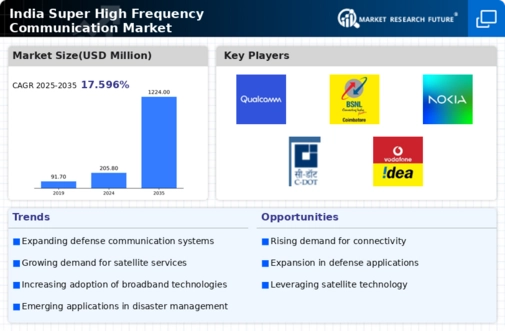Growing Defense Expenditure
The increasing defense expenditure in India is a pivotal driver for the super high-frequency-communication market. The Indian government has allocated approximately $70 billion for defense in the current fiscal year, which includes investments in advanced communication technologies. This trend indicates a strong commitment to enhancing national security and operational capabilities. As military operations increasingly rely on secure and efficient communication systems, the demand for super high-frequency solutions is likely to rise. The super high-frequency-communication market is expected to benefit from this surge in defense spending, as it provides critical infrastructure for secure military communications. Furthermore, the emphasis on indigenous manufacturing under initiatives like Make in India may further stimulate local production and innovation in this sector.
Emergence of IoT Applications
The emergence of Internet of Things (IoT) applications is a significant driver for the super high-frequency-communication market. As India embraces smart city initiatives and industrial automation, the need for reliable and high-speed communication systems becomes paramount. The super high-frequency-communication market is expected to play a vital role in facilitating real-time data transmission between IoT devices. With projections indicating that the number of connected devices in India could reach 1 billion by 2025, the demand for efficient communication solutions is likely to surge. This growth in IoT applications necessitates advanced communication technologies that can handle large volumes of data, thereby creating opportunities for the super high-frequency-communication market to expand.
Rising Cybersecurity Concerns
Rising cybersecurity concerns are driving the super high-frequency-communication market in India. As cyber threats become more sophisticated, organizations are increasingly prioritizing secure communication channels. The Indian government has recognized this need, implementing various initiatives to bolster cybersecurity measures across sectors. The super high-frequency-communication market is poised to benefit from this heightened focus on security, as these systems offer enhanced encryption and protection against eavesdropping. With an estimated 30% increase in cybersecurity budgets across industries, the demand for secure communication solutions is likely to grow. This trend suggests that organizations will seek advanced communication technologies to safeguard sensitive information, thereby propelling the super high-frequency-communication market forward.
Increased Focus on Research and Development
Increased focus on research and development (R&D) within the telecommunications sector is driving innovation in the super high-frequency-communication market. The Indian government has announced various funding initiatives aimed at promoting R&D in communication technologies, with an investment of approximately $1 billion over the next five years. This commitment to innovation is likely to lead to the development of advanced super high-frequency communication systems that meet the evolving needs of various industries. As companies invest in R&D to enhance their product offerings, the super high-frequency-communication market may witness a surge in new technologies and applications. This focus on innovation could potentially position India as a leader in the development of cutting-edge communication solutions.
Expansion of Telecommunications Infrastructure
The expansion of telecommunications infrastructure in India is significantly influencing the super high-frequency-communication market. With the government's push for digital India, investments in telecom infrastructure have surged, with an estimated $10 billion allocated for the development of 5G networks. This expansion necessitates advanced communication technologies, including super high-frequency systems, to support high data rates and low latency. As urban areas grow and rural connectivity improves, the demand for robust communication solutions is expected to increase. The super high-frequency-communication market stands to gain from this infrastructure development, as it plays a crucial role in enabling seamless communication across various sectors, including education, healthcare, and e-governance.
















Leave a Comment